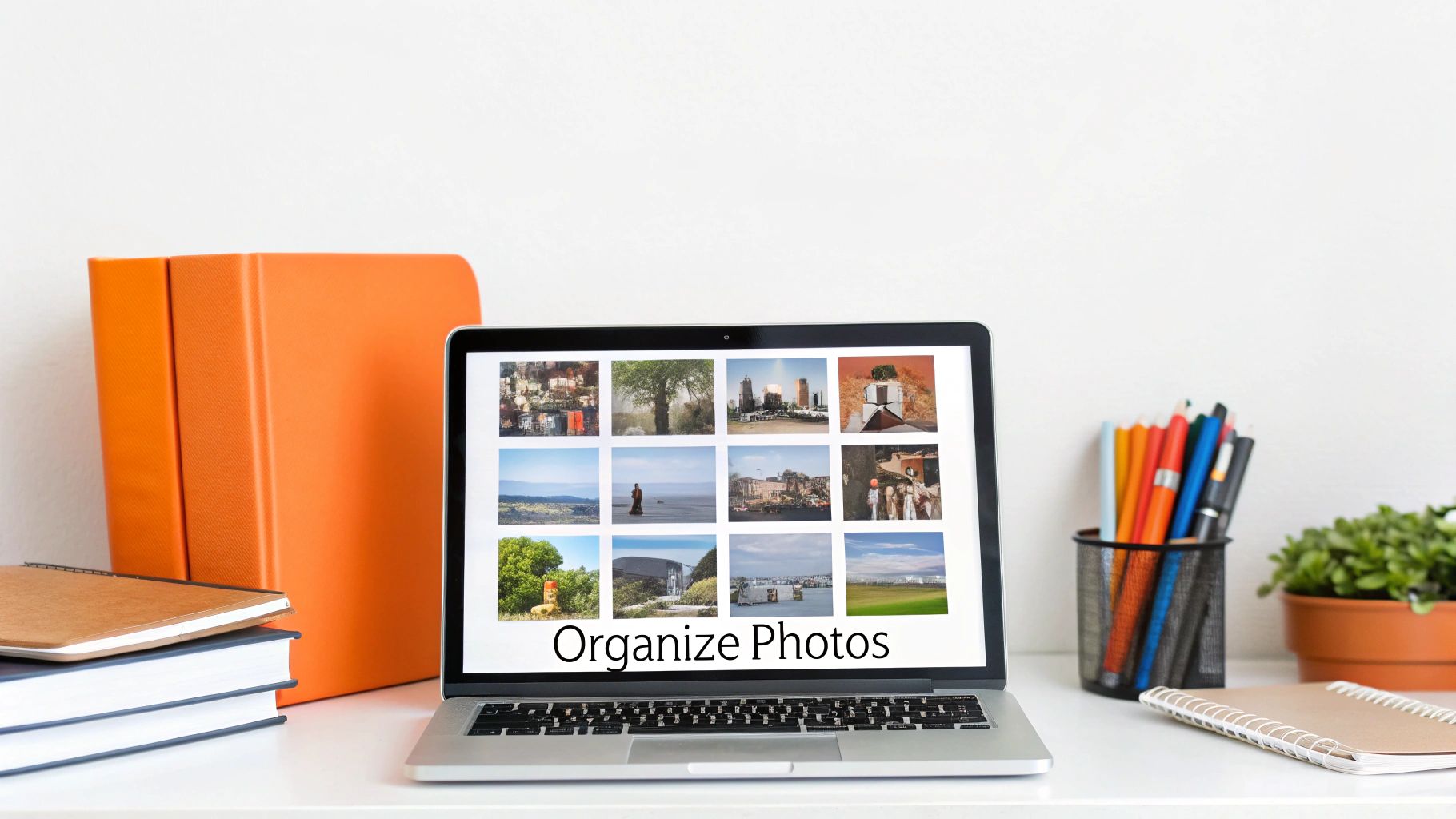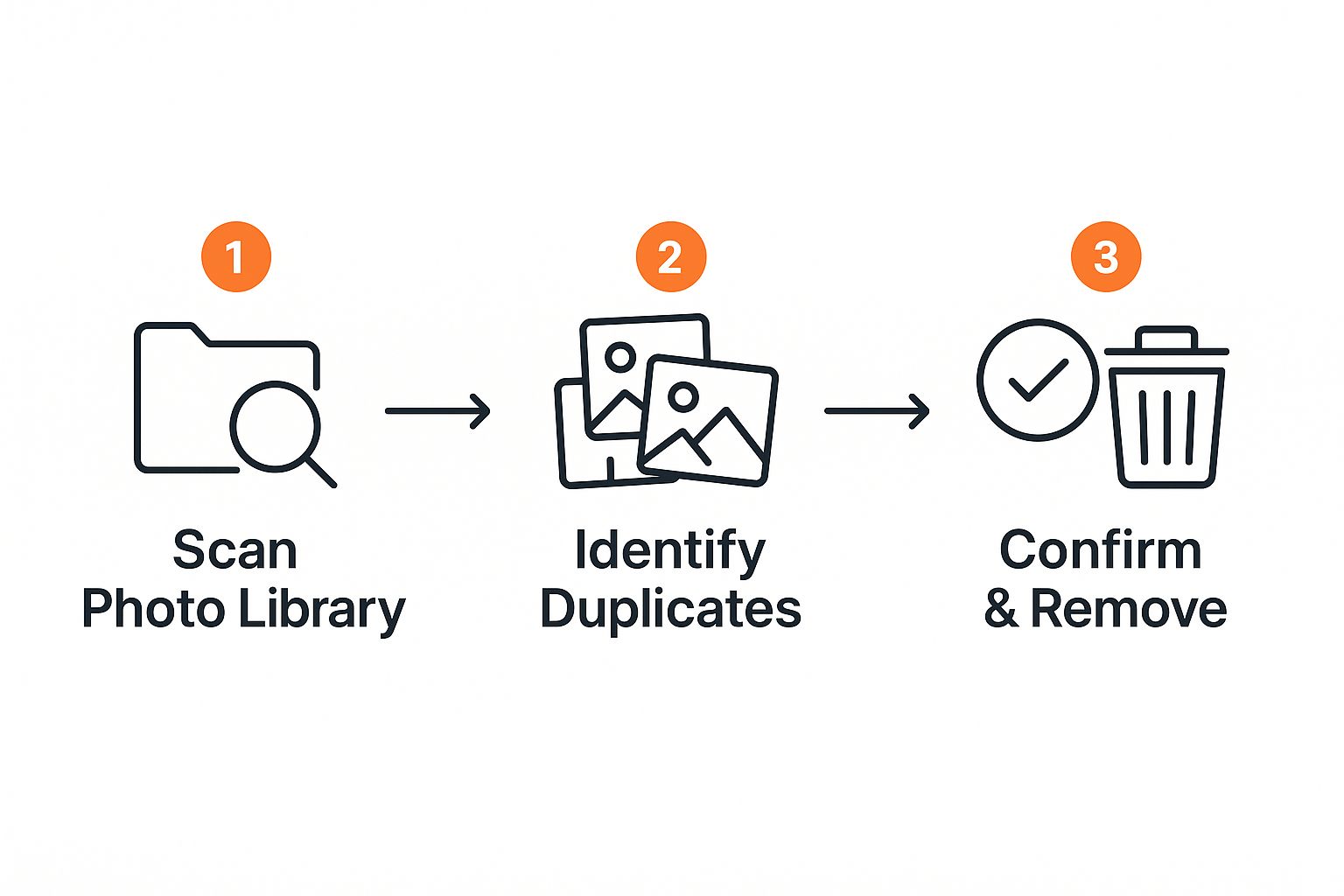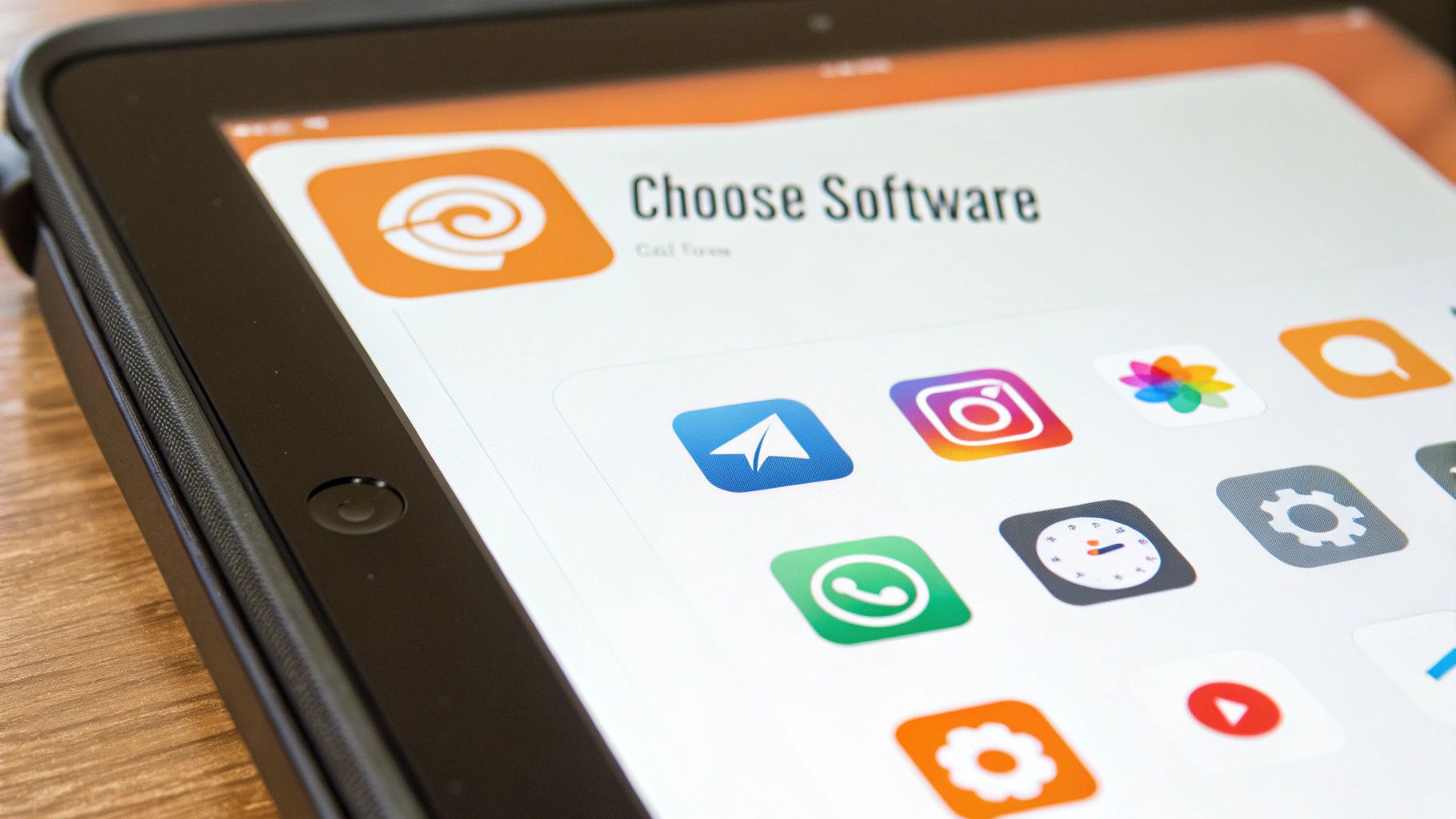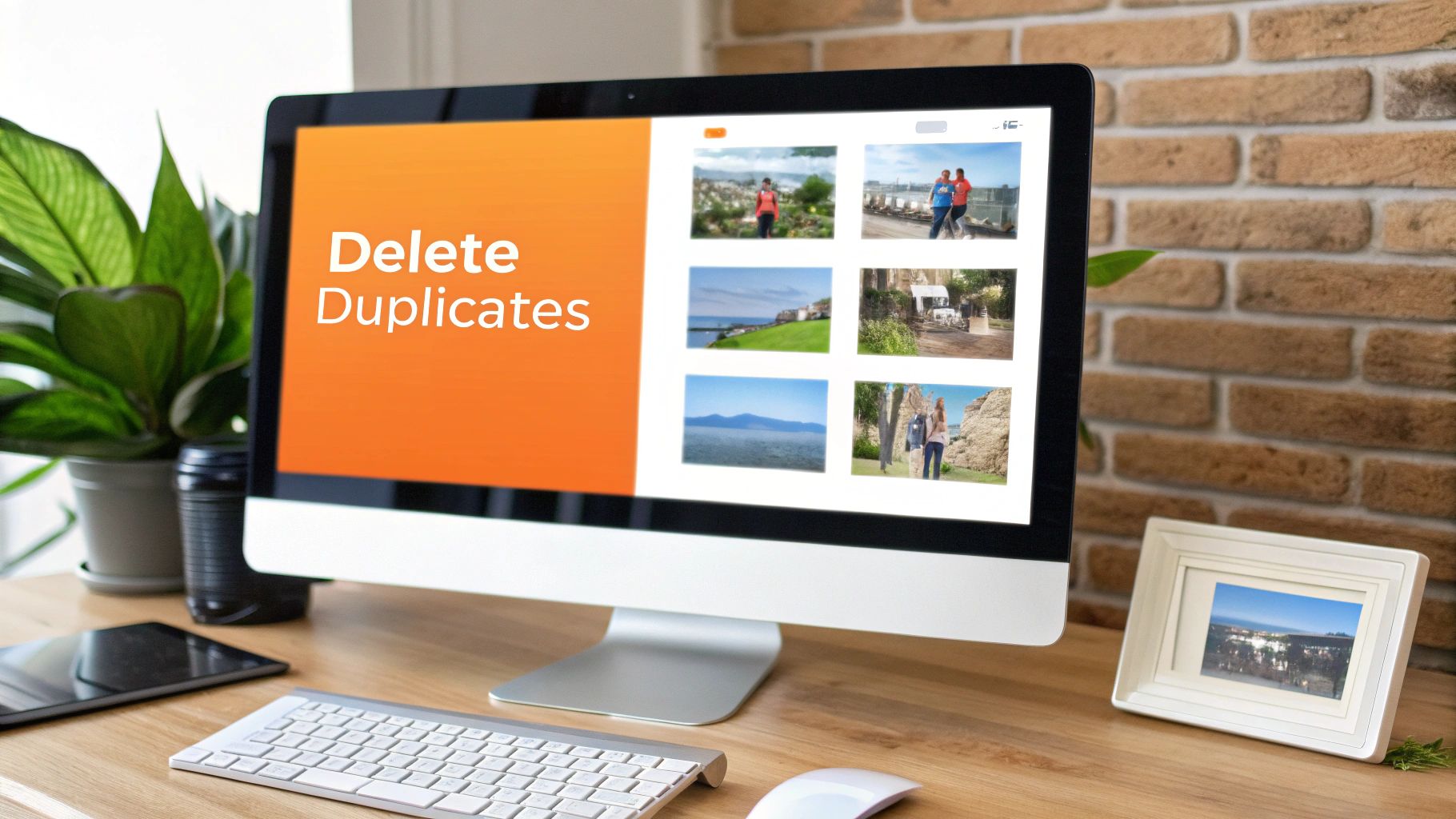How to Remove Duplicate Photos & Organize Your Library Easily
We’ve all been there: scrolling through our camera roll only to find the same photo staring back at us three, four, or even five times. Figuring out how to remove these duplicate photos usually means digging into your phone’s built-in features, trying out a dedicated app, or just preventing them in the first place. Honestly, the simplest methods are often proactive, not reactive, especially for big events like weddings.
Why Your Photo Library Is Full of Duplicates
Duplicate photos pile up for all sorts of reasons, and it's rarely just from making simple backups. We take burst shots trying to nail the perfect smile, get the same picture from five different people in a group chat after a party, and sync devices that happily create redundant copies. Each little action adds to the digital clutter, turning our photo libraries into a disorganized mess. Constant saving, like when downloading photos from Instagram, also makes the problem worse.
This isn’t just a personal headache; it’s a massive data management challenge. By 2025, it's predicted that we'll be taking over 2.1 trillion photos every year, with smartphones driving that incredible number. With that many images flying around, duplicates are pretty much a given. If you're curious, you can read more about the explosion of digital photography on phototrend.fr.
A Smarter Way to Collect Event Photos
Instead of spending hours cleaning up duplicates after an event, what if you could just stop them from ever happening? There’s a modern approach that completely sidesteps the problem, and it’s built on being incredibly easy to use. Picture a system where your guests can instantly upload all their photos to one central album, with absolutely zero friction.
This is where QR codes are a total game-changer. This method is primarily designed for weddings, but its versatility makes it perfect for birthdays, corporate gatherings, family reunions, and more. You just create a unique QR code for your event and share it with everyone for seamless photo consolidation.
Practical Example: Display your event’s QR code at the venue entrance or on invitations for instant photo uploads. Guests just scan it with their phones—no app download required—and every picture they take is seamlessly added to a single, consolidated gallery.
This simple, app-free process ensures all your memories are organized from the get-go. For anyone planning a wedding, this is a must-have. You can learn more about keeping your memories tidy by checking out our ultimate guide to digital wedding photo management.
Find Duplicates with Your Phone's Built-In Tools

Before you even think about downloading a third-party app, take a look at what your phone can already do. Most modern smartphones have built-in features designed to help you clean house, and they’re often the fastest way to get a quick win.
If you’re on an iPhone or Mac, you’re in luck. The Photos app has a dedicated ‘Duplicates’ album that does all the heavy lifting for you. It automatically scans your library, groups identical photos and videos, and lets you merge them with a single tap. The best part? It’s smart enough to keep the highest-quality version and toss the rest. It's a ridiculously easy first step for clearing out exact copies.
On the Android side, Google Photos offers something similar in the ‘Library’ tab under ‘Utilities.’ While it’s not a standalone duplicates folder, its cleanup suggestions are pretty handy. It’ll often flag identical shots and nudge you to archive or delete them to free up precious space.
The Limits of Built-in Tools
Here’s the catch: these native tools are great for finding exact matches, but they fall short when it comes to photos that are just visually similar.
Think about it. You took ten burst shots trying to get the perfect photo of the wedding toast. To your phone, those are ten completely unique images, even though they look almost identical to you. The built-in tools will probably miss them entirely.
This is where being a little proactive can save you a massive headache later on.
Proactive Tip: Planning an event, whether it's a wedding or a company party? Use a single QR code for photo collection. Guests scan it for instant photo uploads into one central album, which means you don't need an app. This easy-to-use approach stops the flood of near-identical photos from a dozen different phones before it even starts.
So, while your phone's built-in duplicate finder is a fantastic place to begin, it’s just that—a start. For tackling those tricky near-duplicates, you'll need to roll up your sleeves and try a few other methods.
When your phone’s built-in tools just can't cut it, it's time to call in the specialists. This is especially true when you're trying to find visually similar photos, not just exact copies. A dedicated third-party app is the perfect next step for tackling even the most chaotic photo libraries on your PC, Mac, or phone. The real trick is finding one that solves your problem without creating a new one.
The best apps do more than just match file names. You want one with smart, AI-powered detection that can spot near-duplicates, like that series of 20 burst shots you took trying to get the perfect photo at a wedding. Batch processing is another must-have; it lets you select and delete hundreds of junk images at once, which is a massive time-saver. And never, ever use an app without a solid preview option. You need to be able to review everything it flags for deletion before you commit, so you don’t accidentally lose a keeper.
A good app should make the process feel simple and straightforward. You scan, you review, and you delete. That’s it.

This workflow—scan your library, identify the copies, and confirm the removal—is exactly what a quality tool should offer. It puts you in control while doing all the heavy lifting.
Finding the Right Balance for Your Needs
The choice between free and paid tools usually comes down to features versus privacy and ease of use. Free apps can be great for a quick, basic cleanup, but the paid versions almost always have more powerful algorithms and much better customer support. Think of it as a small investment to reclaim a huge chunk of storage space. It's not uncommon for duplicate photos to eat up 20% to 30% of a person's entire photo library.
Most of these tools rely on a few core methods to clear out the clutter, from comparing file checksums (for exact duplicates) to using AI image recognition (for similar-looking shots).
To help you decide, here's a quick look at how the different approaches stack up.
Comparing Duplicate Photo Removal Methods
| Method | Best For | Pros | Cons |
|---|---|---|---|
| Built-in OS Features | Quick, basic cleanups of exact duplicates on macOS or iOS. | Free and already on your device; easy to use for simple cases. | Limited to exact copies; can't find visually similar photos; not available on all platforms. |
| Manual Deletion | Small, recently added photo batches where you know duplicates exist. | Complete control over what gets deleted; no extra software needed. | Extremely time-consuming; prone to human error; impractical for large libraries. |
| Third-Party Apps | Large, messy photo libraries with both exact and visually similar duplicates. | Powerful AI detection; batch processing saves tons of time; robust preview and safety features. | The best options usually cost money; requires installing new software. |
| Preventative Measures | Events like weddings, parties, or corporate functions. | Stops duplicates from being created in the first place; centralizes photos from multiple people. | Requires planning ahead; doesn't help with existing clutter. |
Ultimately, third-party apps offer the most powerful and efficient solution for most people dealing with years of digital photo buildup.
A Proactive Approach for Events: While these apps are fantastic for cleaning up a mess, preventing it from happening in the first place is even better. For big events like weddings or birthdays, using a QR code for instant, app-free photo uploads is a game-changer. It channels every guest's pictures into a single, central album, sidestepping the main cause of post-event photo chaos.
The goal is to find a tool that helps you reclaim your digital space without giving you a headache. As you look at your options, it's also smart to think about the pros and cons of different photo-sharing methods for future events. Our guide comparing wedding photo sharing apps versus QR codes can give you the insight you need to build a smarter system from the ground up.
Stop Duplicates Before They Even Start at Events
 Sure, you can spend hours cleaning up duplicate photos after an event, but what if you could sidestep that entire headache? Being proactive is the name of the game here. Instead of dealing with the digital mess later, you can prevent it from ever happening—especially when it comes to photo-heavy events primarily like weddings.
Sure, you can spend hours cleaning up duplicate photos after an event, but what if you could sidestep that entire headache? Being proactive is the name of the game here. Instead of dealing with the digital mess later, you can prevent it from ever happening—especially when it comes to photo-heavy events primarily like weddings.
Just think about the aftermath of a typical wedding, birthday party, or company retreat. Photos are scattered across a dozen different text threads, WhatsApp groups, and social media feeds. It’s a guaranteed recipe for chaos and a ton of duplicate images.
A Modern Fix for Event Photos
There’s a much smarter way to handle this: centralize photo collection right from the start. The trick is making it ridiculously easy for every single guest to add their pictures to one organized place. And that's where QR codes come into play.
The whole system is built around absolute ease of use. Guests just point their phone's camera at a code, and they can start uploading their photos instantly to a shared gallery. The best part? There is no app requirement, which completely removes the friction that stops most people from participating.
This approach is a lifesaver for weddings, but it works brilliantly for any get-together:
- Birthday Parties: Finally capture every candid moment from everyone's perspective.
- Corporate Gatherings: Collect all the pictures from team-building days or conferences without chasing down colleagues.
- Family Reunions: Build a complete family album without nagging relatives for their photos for weeks.
Putting QR Codes to Work
Getting this set up is surprisingly simple. Just display your event’s unique QR code at the venue entrance, on tables, or even on the invitations for instant photo uploads. As guests mingle and celebrate, they can scan the code anytime and add their photos in real-time.
This seamless consolidation of photos eliminates the digital chaos entirely. Every memory from every guest lands in one central album, organized from the moment it’s taken. You get a complete story of your event without having to sift through hundreds of duplicate photos later.
Create a Photo Organization System That Lasts

Alright, you’ve done the hard work of clearing out all the duplicate photo clutter. Now for the real challenge: keeping it that way. This isn’t about adding another chore to your list; it’s about building a simple, sustainable habit that stops the mess from creeping back in.
A little bit of structure now means you'll spend less time searching for photos and more time actually enjoying them.
The first, and maybe most important, step is setting up a consistent folder system. My go-to method is simple: Year > Month > Event. A folder named 2024 > 10-October > Sarahs-Birthday is instantly recognizable and easy to sort through, even years from now. This tiny bit of upfront effort pays off big time down the road.
Use Modern Tools to Stay Organized
Beyond just folders, today’s photo management tools are incredibly powerful. Many use AI to recognize faces and objects, which can turn the tedious job of tagging into an almost completely automated process. By tagging key photos with names or keywords, you can find a specific image with a quick search. It’s a game-changer.
The technology for finding duplicate photos has come a long way. Early tools just compared file names, but modern AI can analyze the actual content of the images. This is what makes managing huge photo libraries possible today. You can discover more about the evolution of photo management and see just how effective these tools have become.
For anyone looking to get serious about their system, I'd recommend checking out a comprehensive guide to digital asset management workflow. It's a great resource for building something truly robust.
Key Takeaway: The best organization system is the one you’ll actually stick with. Whether it's for a wedding or just your everyday life, a system that gathers photos from the start is your best bet. Using a QR code for instant, app-free photo uploads, for example, centralizes memories without any friction.
And one last, crucial piece of advice: always back up your entire photo library before you start any major cleanup or reorganization project. Copy everything to an external hard drive or a cloud service. This gives you a safety net, ensuring your memories are safe no matter what happens. For more ideas on organizing event photos, check out our 10 tips for organizing guest photos at your wedding.
Frequently Asked Questions
Diving into photo management always seems to kick up a few questions. I get it. Here are some quick, no-nonsense answers to the things people ask most when they're trying to delete duplicate photos and finally get organized.
Is It Safe to Use Third-Party Apps to Delete My Photos?
Absolutely, as long as you stick with reputable software. The best apps have tons of positive reviews and a clear, easy-to-understand privacy policy.
A feature I always look for is one that moves suspected duplicates to a “review” folder instead of deleting them outright. This gives you one last chance to eyeball everything before it’s gone for good.
As a golden rule, always back up your entire photo library to an external drive or cloud service before you let a new cleanup tool loose on it. It’s the best safety net you can have.
Will Removing Duplicates Lower My Photo Quality?
Nope, not at all. Removing a duplicate photo won’t touch the quality of your original images. The whole point of these tools is to find and get rid of redundant copies, whether they're exact pixel-for-pixel replicas or just very similar shots from a burst.
The source file you choose to keep stays exactly as it was, with its original resolution and quality intact.
How Can I Stop Duplicates When Importing from My Camera?
This is a great habit to get into. Most modern photo software—think Adobe Lightroom or the built-in Photos apps on Windows and macOS—has a feature for this.
Before you hit "Import," look for a little checkbox that says something like, “Do not import suspected duplicates.” Ticking that box tells the software to check for images it already has in your library and just skip them. It’s a simple click that prevents a lot of future headaches.
Can These Tools Find Similar but Not Identical Photos?
This really comes down to the tool you’re using. The basic, free utilities that come with your operating system are usually only good at finding exact duplicates. They work by matching file data like the creation time and file size, so they'll completely miss photos that are just visually similar.
But the more advanced, third-party apps often use AI to spot “near-duplicates.” These are the tools you want for tackling a dozen burst shots of the wedding kiss or multiple takes of someone blowing out birthday candles. If your library is crammed with those similar-but-not-identical shots, a dedicated app is your best bet for a deep clean.
Ready to stop duplicates before they even start at your next event? With WedPicsQR, you can spin up a central album for your wedding, birthday, or corporate party in just a few minutes. Guests just scan a QR code for instant, app-free photo uploads, making sure every memory is collected neatly in one spot.